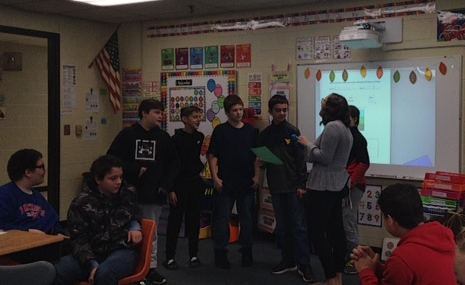 A tower hydroponic system that had been working flawlessly for Wheeling Middle School seventh and eighth grade classes suddenly had an aphid infestation. Oh no, there goes the holiday salad buffet! However, rather than seeing this insect infestation as a calamity, Wheeling Middle School teachers transformed the aphid problem into an opportunity for student-initiated learning.
A tower hydroponic system that had been working flawlessly for Wheeling Middle School seventh and eighth grade classes suddenly had an aphid infestation. Oh no, there goes the holiday salad buffet! However, rather than seeing this insect infestation as a calamity, Wheeling Middle School teachers transformed the aphid problem into an opportunity for student-initiated learning.

Teachers were preparing to harvest the lettuce and all remaining salad greens from the tower when they, “…noticed the lettuce is covered in aphids…I think they are aphids. They are tiny green bugs. We are going to pick [the remaining plants] tomorrow. Can they just be rinsed off? How can we make sure that the new [plants] we put in the tower don’t get them?”
When I reached the school mid-afternoon the next day, I could see that the students had taken ownership of the aphid infestation problem. When I arrived the teachers and students were finishing up their aphid response plan. The lead teacher, Jenny Craig, organized a group of her students to describe the problem they’d had, what they learned from their research that day, the solution they devised, and steps they identified to reduce the risk of this problem in the future.
Here’s what I learned from the Wheeling Middle School students today.
The insect infestation was definitely aphids—most likely stem and leaf aphids. The students used their Chrome Books to find photos and descriptions of aphids to confirm this hypothesis.

Next, students described the procedures they used to capture and eliminate the aphids that were gorging on the lettuce leaves. They cut each lettuce plant at its base and dropped it into a bucket of cool water. They quickly dunked the lettuce down into the deep water in forceful, repeated plunges to remove the aphids from the lettuce leaves. Once the lettuce was clear of bugs, they examined the bucket of water and saw that hundreds of aphids were floating on the water surface.
Students learned from their research that spraying the tower system with a mixture of soap and water provides a low-toxicity bug control solution that will desiccate the soft bodies and kill the aphids without doing harm to your plants or their human caretakers. Just mix a few teaspoons of liquid dish soap with one quart of water, then spray or wipe the solution onto the leaves, stems, and buds of the plant. Repeat the process every two or three days for the next few weeks, until you no longer notice aphids on the plant.
Students also shared a few additional tips about how to get rid of aphids from hydroponic plants. You can vary the soap-water mix to include cayenne pepper: Stir together 1 quart water, 1 tsp liquid dish soap, and a pinch of cayenne pepper. Do not dilute before spraying on plants.
If the soapy water spray doesn’t adequately address your aphid problem. Neem oil is an effective horticultural tool to address aphids. Follow the application instructions provided with the Neem oil packaging.
Fortunately, the aphid infestation occurred right before the school’s December holiday break. After harvesting and running soapy water through the tower system, the middle schoolers were able to empty and clean out their tower system, plant baskets, and clay pebble substrate with a solution of 9 parts water, 1 part bleach. Their tower system will be ready for a freshwater rinse and reuse when school begins in 2020.
These resources provide helpful guidelines for eliminating and hopefully preventing aphid infestations.
- BugGuide: Identification, Images, & Information For Insects, Spiders & their Kin for the United States and Canada. Accessed December 18, 2019 at https://bugguide.net/node/view/412604
- Jennifer Noonan, How To: Get Rid of Aphids. Accessed December 18, 2019 at https://www.bobvila.com/articles/how-to-get-rid-of-aphids/
- The Old Farmer’s Almanac, How to Identify and Get Rid of Aphids, Accessed December 20, 2019 at https://www.almanac.com/pest/aphid
